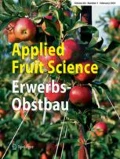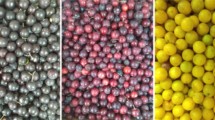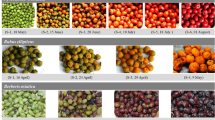Abstract
Wild pear (Pyrus eleagnifolia) is a naturally grown species mainly in inner Anatolia and its edible small fruits are traditionally consumed by local peoples and are called “Ahlat” in Turkey. Its seedlings are also used as rootstock for commercial pear cultivars. In this study, we reported first time pomological characteristics and biochemical compositions in fruits of a wide number selected wild pears genotypes (Pyrus eleagnifolia Pall.) from inner Anatolia. The obtained results revealed that there were significant differences among wild pear genotypes for all analyzed parameters. Fruit weight, total phenolics, total acidity and total sugar contents of the fruits varied from 4.71 to 27.09 g, 42.79 to 119.14 mg GAE/100 g, 0.20 to 1.40 g/100 g and 8.36 to 19.31 g/100 g, respectively. Considering these values, it was concluded that naturally grown wild pears of Anatolia with their rich salubrious biochemical compounds could reliably be used as a food source for humans.
Zusammenfassung
Die Ölweidenblättrige Birne kommt hauptsächlich im Inneren Anatoliens natürlich vor und ihre genießbaren, kleinen Früchte werden traditionell von den ortsansässigen Bewohnern verzehrt. Die Früchte werden in der Türkei „Ahlat“ genannt. Ihre Sämlinge werden ebenfalls als Unterlagen für kommerziell angebaute Birnensorten verwendet. In dieser Untersuchung berichteten wir erstmals über pomologische Eigenschaften und biochemische Zusammensetzungen einer umfangreichen Anzahl an Früchten ausgewählter Wildbirnen-Genotypen (Pyrus eleagnifolia Pall.) aus dem Inneren Anatoliens. Die gewonnenen Ergebnisse zeigten, dass es zwischen den Genotypen der Wildbirne bei allen untersuchten Parametern signifikante Unterschiede gab. Das Fruchtgewicht, der Gesamt-Phenolgehalt, die Gesamt-Säure und der Gesamt-Zuckergehalt der Früchte variierten jeweils zwischen 4,71 und 27,09 g, von 42,79 bis 119,14 mg GAE/100 g, von 0,20 bis 1,40 g/100 g und von 8,36 bis 19,31 g/100 g. Diese Werte lassen den Schluss zu, dass natürlich gewachsene Ölweidenblättrige Birnen aus Anatolien mit ihren gesunden, biochemischen Inhaltsstoffen zuverlässig als Nahrungsquelle für den Menschen genutzt werden könnten.

Similar content being viewed by others
References
Baytop T (2004) Therapy with medicinal plants in Turkey (past and present). Nobel Press, Istanbul, p 353
Buttner R (2001) Pyrus. In: Hanelt, P. Institute of Plant Genetics and Crop Plant Researches (ed) Mansfelds encyclopedia of agricultural and horticultural crops, pp. 462–471 Springer, Gaterslaben.
Cansaran A, Kaya OF, Yıldırım C (2007) A ethnobotany study in Ovabasi, Akpinar, Gulluce and Koseler villages in Gumushacikoy district/Amasya province. Firat Univ Sci Eng J 19(3):243–257
Cemeroglu B (2007) Food analysis. Food Technol Union 34:535
Chen J, Wang Z, Wub J, Wang Q, Hub X (2007) Chemical compositional characterization of eight pear cultivars grown in China. Food Chem 104:268–275
Craig W, Beck L (1999) Phytochemicals: health protective effects. Can J Diet Pract Res 60:78–84
Ercisli S (2004) A short review of the fruit germplasm resources of Turkey. Genet Res Crop Evol 51:419–435
Ercisli S, Orhan E (2008) Some physico-chemical characteristics of black mulberry (Morus nigra L.) genotypes from Northeast Anatolia region of Turkey. Sci Hort 116:41–46
Ercisli S, Sengul, Yildiz H, Sener D, Duralija B, Voca S, Purgar DD (2012) Phytochemical and antioxidant characteristics of medlar fruits (Mespilus germanica L.). J Appl Bot Food Qual 85:86–90
Fourie PC, Hansmann CF, Oberholzer HM (1991) Sugar content of fresh apples and pears in South Africa. J Agric Food Chem 39:1938–1939
Hussain S, Masud T, Ali S, Bano R, Ali A (2013) Some physico-chemical attributes of pear (Pyrus communis L.) cultivars grown in Pakistan. Int J Biosci 3(129):206–215
Jurikova T, Rop O, Mlcek J, Sochor J, Balla S, Szekeres L, Hegedusova A, Hubalek J, Adam V, Kizek R (2011) Phenolics profile of edible honeysuckle berries (Genus Lonicera) and their biological effects. Molecules 17(1):61–79
Jurikova T, Sochor J, Rop O, Mlcek J, Balla S, Szekeres L, Adam V, Kizek R (2012) Polyphenolics profile and biological activity of Chinese hawthorn (Crataegus pinnatifida BUNGE) fruits. Molecules 17(12):14490–14509
Karadeniz F (1999) A research on the chemical composition of pear juice. Turk J Agric For 23:355–358
Karadeniz F, Burdurlu HS, Koca N, Soyer Y (2005) Antioxidant activity of selected fruits and vegetables grown in Turkey. Turk J Agric For 29:297–303
Keles H, Akca Y, Ercisli S (2014) Selection of promising walnut genotypes (Juglans regia L.) from inner Anatolia. Acta Sci Pol Hortorum Cultus 13(3):167–173
Koc A, Bilgener S (2013) Morphological characterization of cherry rootstock candidates selected from Samsun Province in Turkey. Turk J Agric For 37(5):575–584
Marinova D, Ribarova F, Atanassova F (2005) Total phenolics and total flavonoids in Bulgarian fruits and vegetables. J Univ Chem Tech Metal 40:255–260
Ozturk I, Ercisli S, Kalkan F, Demir B (2009) Some chemical and physico-mechanical properties of pear cultivars. Afr J Biotechnol 8(4):687–693
Radivojevic DD, Milivojevic JM, Oparnica CDj, Vulic TB, Djordjevic BS, Ercisli S (2014) Impact of early cropping on vegetative development, productivity, and fruit quality of Gala and Braeburn apple trees. Turk J Agric For 38(6):773–780
Saldamli I (2007) Food chemistry. Hacettepe University Publication, Ankara, pp 463–492 (in Turkish)
Salta J, Martins A, Santos RG, Neng NR, Nogueira JMF, Justino J, Rauter AP (2010) Phenolics composition and antioxidant activity of Rocha pear and other pear cultivars—A comparative study. J Funct Foods 2:153–157
Sanchez GAC, Angel GI, Maria IG (2003) Comparative study of six pear cultivars in terms of their phenolics and vitamin C contents and antioxidant capacity. J Sci Food Agric 83:995–1003
Schieber A, Keller P, Carle R (2001) Determination of phenolics acids and flavonoids of apple and pear by high-performance liquid chromatography. J Chromatogr 910:265–273
Sengul M, Eser Z, Ercisli S (2014) Chemical properties and antioxidant capacity of cornelian cherry genotypes grown in Coruh valley of Turkey. Acta Sci Pol Hortorum Cultus 13(4):73–82
Singleton VL, Rossi JA (1965) Colorimetry of total phenolics with phosphomolybdic-phosphotungstic acid reagents. Amer J Enol Vit 16:144–158
Tanaka M, Kuei CW, Nagashima Y, Taguchi T (1998) Application of antioxidative maillrad reaction products from histidine and glucose to sardine products. Nippon Suisan Gakkaishi 54:1409–1414
Yerliturk FU, Arslan O, Sinan S, Gencer N, Ozensoy GO (2008) Characterization of polyphenoloxidase from wild pear (Pyrus elaegnifolia). J Food Biochem 32:368–383
Yildiz H, Sengul M, Celik F, Hegedus A, Ercisli S, Tosun M (2010) Some phytochemical and antioxidant characteristics of wild and cultivated blackberry (Rubus caucasicus) fruits. J Food Agric Environ 8(3&4):156–159
Yilmaz KU, Ercisli S, Zengin Y, Sengul M, Kafkas E (2009) Preliminary characterisation of cornelian cherry (Cornus mas L.) genotypes for their physico-chemical properties. Food Chem 114:408–412
Acknowledgements
The authors are grateful to the Erciyes University Scientific Research Projects Unit (Project No: FBA-10-3302) for the financial support.
Author information
Authors and Affiliations
Corresponding author
Rights and permissions
About this article
Cite this article
Ugurtan Yilmaz, K., Ercisli, S., Cam, M. et al. Fruit Weight, Total Phenolics, Acidity and Sugar Content of Edible Wild Pear (Pyrus elaeagnifolia Pall.) Fruits. Erwerbs-Obstbau 57, 179–184 (2015). https://doi.org/10.1007/s10341-015-0246-6
Received:
Accepted:
Published:
Issue Date:
DOI: https://doi.org/10.1007/s10341-015-0246-6




